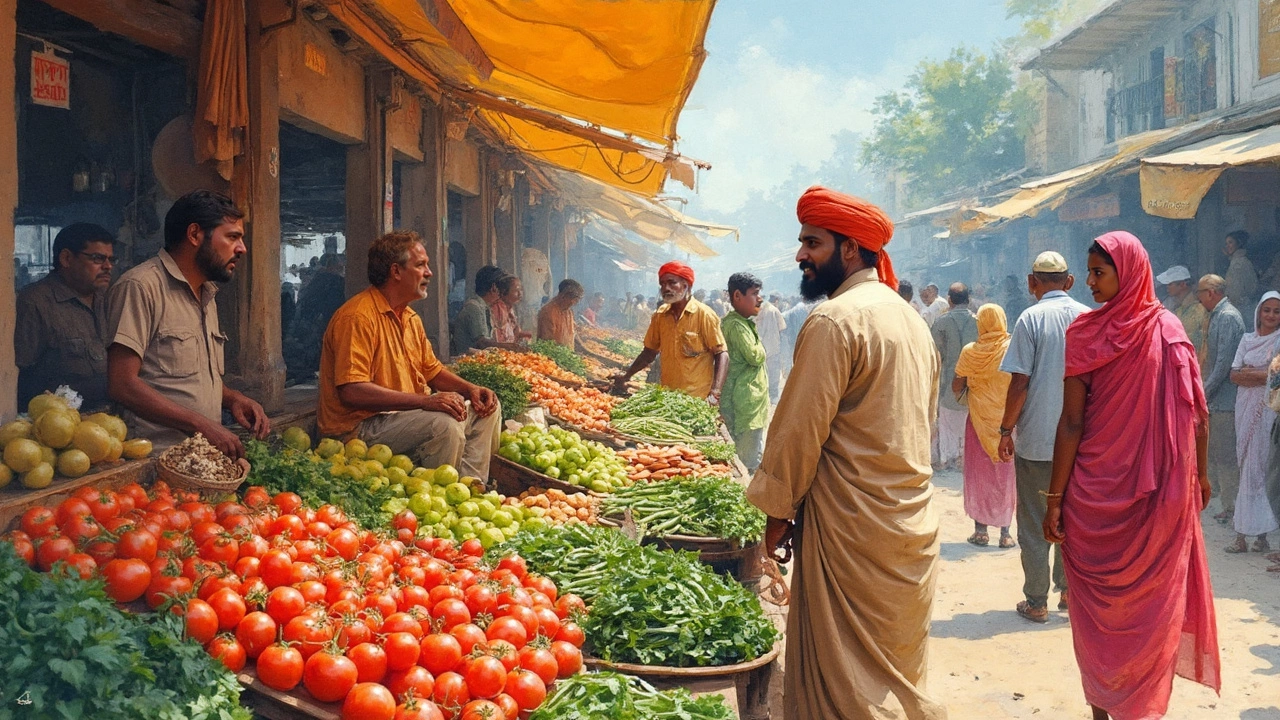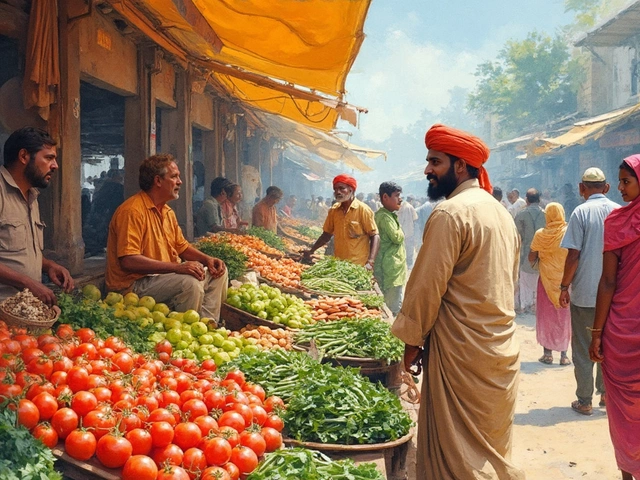Ever walked through an Indian vegetable market and thought, 'Wow, these prices keep climbing!'? You're definitely not alone. With vegetables becoming pricier, it's hard to ignore the pinch in your wallet. But why is this happening? Let's dive into some of the nitty-gritty factors causing this upward trend and maybe figure out how to beat it.
One of the biggest culprits? Climate change. Unpredictable weather patterns, like unexpected rain or droughts, can really mess with how veggies grow. It's simple—less produce means prices shoot up.
Then there's the issue with the supply chain. It's not just about growing veggies; getting them from the farm to your table involves a whole lot of middlemen. When any part of this chain hits a snag, it can lead to higher costs.
And let's not forget demand. As more people move to cities, the need for fresh produce is booming, often outstripping what's available. More demand, not enough supply; you do the math.
But don't worry, there’s something we all can do. Starting a little garden in your backyard or balcony can be a game-changer. With a bit of patience and some tips, you can grow your own veggies and maybe even save some cash.
- Climate Impacts on Vegetable Pricing
- Supply Chain and Distribution Challenges
- Demand vs. Supply Dynamics
- Tips for Home Gardening in India
Climate Impacts on Vegetable Pricing
It's no secret that the climate is changing, and it's putting a real strain on agriculture, causing hikes in vegetable prices across India. Why's that happening? Well, think about it: inconsistent rain, rising temperatures, and sudden droughts. They're all making it harder for farmers to grow the food we rely on.
Rain used to be predictable, but now there are times when it pours too much or not at all. These patterns aren't just messing with crops; they're hitting farmers' pockets, too. Did you know that in 2023, some regions in India experienced over 150% above normal rainfall? That's not good for crops that are sensitive to water intake.
The Ministry of Agriculture stated, "Climate volatility is leading to reduced yields, which in turn inflates market prices."
These weather shifts are particularly tough on sensitive crops like tomatoes and onions. They need certain conditions to thrive, but they often don't get them due to unpredictable weather.
Why It Matters
It's not just about the rain. Rising temperatures make it harder to grow things like carrots and spinach that prefer cooler weather. And when you add in factors like pest outbreaks—which thrive in changing climates—it becomes clear why vegetables are getting pricier.
Farmers Are Adapting, But It's Not Easy
Indian farmers aren't just sitting on their hands. Many are trying new methods like drip irrigation or shade nets to protect their crops. While these methods can help, they also come with additional costs, which can again push prices upward.
So, the next time you're in the market and wondering why those veggies are costing so much, remember there's a whole slew of climate issues behind that price tag. And maybe, just maybe, consider growing a few of your own vegetables at home.
Supply Chain and Distribution Challenges
Ever noticed how veggies can be super expensive in India? A huge part of it boils down to the tangled web that is the supply chain. Growing the veggies is only half the battle. Getting them to your plate is a whole different story. Let's break down why things go a bit haywire.
The Journey from Farm to Market
First off, it's all about distance. Many farms are set in rural areas, miles away from your city grocery store. Transporting these fresh veggies over long distances can jack up costs due to fuel prices and vehicle maintenance. Not to forget, the condition of roads in some areas isn't exactly smooth sailing. Poor infrastructure can lead to delays, waste, and eventually price hikes.
The Middlemen Conundrum
Next up, the middlemen. Between the farmer and you, there are often numerous agents involved—distributors, wholesalers, and retailers. Each takes a cut, naturally increasing the final price of the vegetable. While these middlemen are necessary, the amount each adds up to isn't so pocket-friendly.
Storage and Wastage Woes
Another issue is storage. India lacks adequate cold storage facilities, essential for keeping perishable produce fresh. Without these, a chunk of the produce spoils and doesn’t make it to market, hiking prices as supply dips. Investment in better storage could make a huge difference.
Stats to Know
| Factor | Impact on Price Increase |
|---|---|
| Transport Costs | 15% |
| Middlemen Fees | 10-20% |
| Storage Losses | Up to 25% |
Addressing these challenges isn’t an overnight job, but it’s good to know why our grocery bills are on the rise. With more efficient systems and better infrastructure, hopefully, these issues can be ironed out!

Demand vs. Supply Dynamics
So, why are these vegetable prices going through the roof? Well, it’s all about demand and supply. Imagine the population in major Indian cities booming; that's more mouths to feed, and fresh produce is at the top of everyone's list.
With urbanization, people are moving from rural areas to cities in droves. More folks in cities create a surge in demand for fresh veggies, but what about the supply? It's often lagging behind. Farms on the outskirts struggle to catch up, and transportation issues only make it worse.
The Urban Population Boom
Cities in India are expanding, and so are the number of residents. It's projected that urban populations will continue to rise, increasing demand further. This imbalance between swelling demand and sluggish supply leads to inflated prices.
A Look at the Numbers
Let’s peek into some numbers to see what's happening. According to recent data from 2023, urban areas have seen a 20% rise in vegetable consumption compared to two years ago, while production growth hovers around 5%. Here's how these figures stack up:
| Year | Growth in Urban Consumption | Growth in Production |
|---|---|---|
| 2022 | 15% | 4% |
| 2023 | 20% | 5% |
As you can see, demand outstrips supply, and this gap is a major factor in driving up prices.
Bridging the Gap
The real challenge lies in closing this gap. Encouraging urban gardening, improving supply chain efficiencies, and investing in technology-driven farming can play significant roles in tackling the issue. Remember, even small efforts towards growing your own veggies at home can contribute to easing some of this demand on a personal level.
Tips for Home Gardening in India
If you're tired of soaring vegetable prices, starting your own garden might just be the solution. Home gardening is not only rewarding but also a fun way to get your hands dirty and enjoy some fresh air. Plus, having fresh produce right at your doorstep isn't too shabby either.
Start Small and Simple
No need to go big right away. A few pots on the balcony or a small patch in the backyard can work wonders. Think of easy-to-grow veggies like tomatoes, chili peppers, and herbs like coriander and mint. They're well-suited to the Indian climate and can thrive with minimal fuss.
Understanding Climate Zones
India's diverse climate means different regions support different crops. Northern areas with cooler temperatures can support carrots and peas, while warmer southern zones are ideal for eggplant and gourds. Knowing your zone helps in selecting the right veggies.
Soil and Fertilizer
Healthy soil makes for healthy plants. Mix in organic matter like compost to enrich your soil. This not only boosts nutrients but also improves soil structure. Using compost not only saves money but it's also a great way to recycle kitchen waste.
Water Wisely
Water, but don't drown your plants. Over-watering is a common rookie mistake. Use a drip irrigation system if possible, which can save water and ensure your plants get just what they need.
Table: Quick Veggie Growth Guide
| Vegetable | Growing Time (weeks) | Best Region |
|---|---|---|
| Tomatoes | 8-12 | All over India |
| Mint | 4-6 | All over India |
| Carrots | 10-12 | North India |
| Eggplant | 7-10 | South India |
Fight Those Pests
Garden pests can be a nightmare. Consider natural pest control methods, like neem oil or companion planting with pest-repellant plants like marigolds. A healthy, diverse garden minimizes pests naturally.
Community and Sharing
Join local gardening groups or online forums. It's a great way to swap seeds or share tips and experiences. Plus, sharing excess produce with friends and family spreads the joy and cuts down on food inflation concerns.
There you have it! With a few simple steps, you can transform your space into a vegetable haven, easing the bite of high vegetable prices and enjoying the fruits (and veggies) of your labor.




